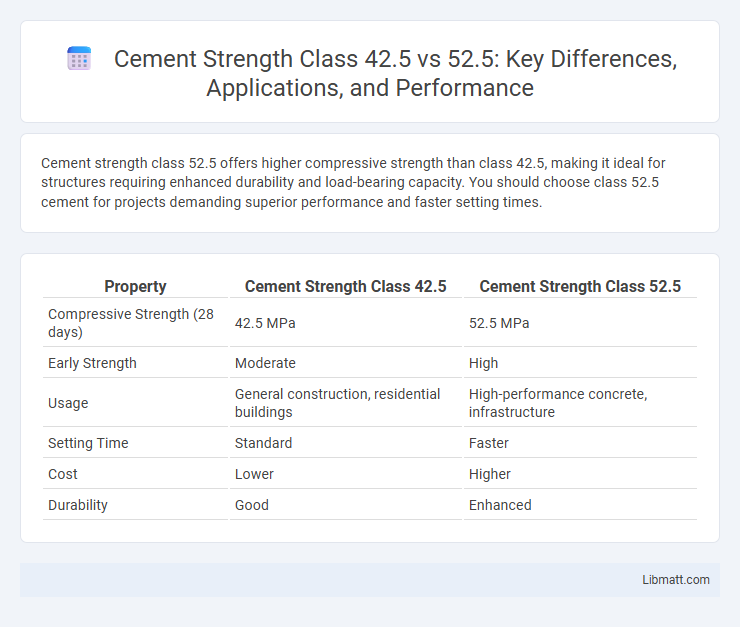Cement strength class 52.5 offers higher compressive strength than class 42.5, making it ideal for structures requiring enhanced durability and load-bearing capacity. You should choose class 52.5 cement for projects demanding superior performance and faster setting times.
Table of Comparison
| Property | Cement Strength Class 42.5 | Cement Strength Class 52.5 |
|---|---|---|
| Compressive Strength (28 days) | 42.5 MPa | 52.5 MPa |
| Early Strength | Moderate | High |
| Usage | General construction, residential buildings | High-performance concrete, infrastructure |
| Setting Time | Standard | Faster |
| Cost | Lower | Higher |
| Durability | Good | Enhanced |
Introduction to Cement Strength Classes
Cement strength class 42.5 indicates a compressive strength of 42.5 MPa after 28 days, commonly used in residential and commercial construction for standard structural applications. Class 52.5 offers higher early strength development with a compressive strength of 52.5 MPa, suitable for high-performance concrete and rapid construction projects. Your choice between these classes impacts the durability, setting time, and cost efficiency of concrete structures.
Understanding the 42.5 and 52.5 Strength Grades
Cement strength classes 42.5 and 52.5 indicate the compressive strength in megapascals (MPa) after 28 days of curing, with 52.5 providing higher strength suitable for structural applications requiring greater load-bearing capacity. The 42.5 grade is commonly used for general construction purposes like residential buildings, offering balanced strength and durability. Understanding these strength grades helps you select the right cement to optimize your project's performance and longevity.
Chemical Composition Differences
Cement strength classes 42.5 and 52.5 primarily differ in their calcium silicate phases, with Class 52.5 exhibiting a higher percentage of tricalcium silicate (C3S), which accelerates strength development. The increased C3S content in strength class 52.5 results in faster hydration reactions and greater early compressive strength compared to 42.5. Understanding these chemical composition differences helps optimize your concrete mix for specific structural performance and durability requirements.
Key Mechanical Properties Compared
Cement strength class 42.5 achieves a compressive strength of 42.5 MPa at 28 days, suitable for standard construction requirements, while class 52.5 attains 52.5 MPa, offering superior load-bearing capacity and faster strength development. Class 52.5 also exhibits higher early strength gain, making it ideal for rapid construction schedules and high-stress applications. Both classes maintain consistent tensile strength and durability, but class 52.5 provides enhanced mechanical performance under demanding structural conditions.
Typical Applications of 42.5 vs 52.5 Cement
Cement strength class 42.5 is commonly used in general construction projects such as residential buildings, pavements, and precast concrete elements due to its adequate compressive strength and durability. Cement class 52.5 is preferred for high-strength concrete applications, including high-rise buildings, industrial floors, and infrastructure requiring rapid strength gain and enhanced mechanical performance. Choosing between 42.5 and 52.5 cement depends on your project's structural requirements and desired curing time.
Performance in Concrete Mixes
Cement strength classes 42.5 and 52.5 differ primarily in their compressive strength, with class 52.5 offering higher early and ultimate strength, which enhances the durability and load-bearing capacity of your concrete mixes. Class 52.5 cement accelerates setting time and improves resistance to chemical attacks, making it ideal for high-performance and fast-track construction projects. Selecting the appropriate cement strength class directly influences workability, curing time, and the overall mechanical properties of the concrete, ensuring optimized performance for your specific structural requirements.
Setting Time and Workability Considerations
Cement strength class 42.5 exhibits a moderate setting time, making it suitable for applications requiring balanced workability and manageable curing periods. Class 52.5 cement offers faster setting times, enhancing early strength development but may demand quicker handling and placement to maintain workability. Selecting between 42.5 and 52.5 strength classes depends on project-specific requirements for setting time precision and the desired workability window during construction.
Cost Implications for Construction Projects
Cement strength class 42.5 typically incurs lower material costs compared to class 52.5, making it a budget-friendly choice for many construction projects with moderate strength requirements. Class 52.5 offers higher compressive strength, reducing the amount of cement needed and potentially lowering overall structural costs despite its higher price per ton. Evaluating your project's load-bearing needs and budget constraints is crucial to determining the optimal balance between cement grades and cost efficiency.
Environmental Impact and Sustainability
Cement strength class 52.5 offers higher compressive strength than class 42.5, allowing for reduced material usage and potentially lowering carbon emissions per cubic meter of concrete. Your choice of class 42.5 may result in slightly higher cement consumption, which can increase the overall environmental footprint due to greater clinker content. Opting for cement with higher strength class contributes to sustainability goals by enabling more efficient construction practices and minimizing resource consumption.
Choosing the Right Cement Strength Class
Choosing the right cement strength class depends on your project's structural requirements and durability demands, with class 42.5 cement offering adequate compressive strength of 42.5 MPa for general construction. For high-performance applications requiring early strength and enhanced load-bearing capacity, class 52.5 cement delivers a stronger compressive strength of 52.5 MPa, ensuring faster setting and improved durability. Understanding these differences helps you optimize material efficiency and long-term performance for your construction needs.
Cement strength class 42.5 vs 52.5 Infographic

 libmatt.com
libmatt.com